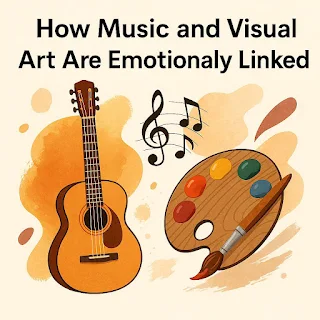Introduction
Music and visual art, while different in form, are remarkably similar in
spirit.
Both are deeply emotional languages that transcend words, cultures, and
borders.
Throughout history, musicians and artists have drawn inspiration from each
other’s mediums, creating work that feels alive with rhythm, movement, and
emotion.
Understanding the emotional link between music and visual art can open new
creative pathways for any artist, designer, or storyteller.
The Shared Language of Emotion
Both music and visual art communicate through elements of rhythm, balance, harmony, and contrast — just in different sensory realms.
In music, rhythm is shaped by beats and timing.
In art, rhythm is created through patterns, repetition, and movement of visual elements.
Similarly:
Music uses major and minor keys to express joy or sadness.
Visual art uses warm or cool colors, sharp or soft lines, and heavy or light compositions to evoke mood.
Both forms bypass the logical brain and go straight to the heart, stirring feelings that are often hard to put into words.
Artists Influenced by Music
Many visual artists openly credit music as a major influence on their creative process:
Wassily Kandinsky, one of the pioneers of abstract art, believed that painting could achieve the same spiritual resonance as a symphony.
He often described his artworks as “visual music.”
Georgia O’Keeffe spoke about how classical music helped her visualize movement and flow in her large-scale paintings.
Modern digital artists today create illustrations and animations while listening to curated playlists that match the energy they want to express visually.
Music can unlock new moods, unexpected colors, and different compositions — fueling a more emotional, instinctive creative flow.
Visual Art Inspired by Musical Concepts
Certain art movements were directly inspired by musical principles:
Synesthesia art involves artists who "see" colors or shapes when hearing sounds, blending the two senses into unified artistic expression.
Jazz-inspired visual art captures the improvisational, free-form spirit of jazz through loose brushstrokes, unexpected patterns, and vivid color contrasts.
Album cover art has evolved into an art form itself, where visuals must capture the mood of entire musical works in a single image.
Even simple music concepts like tempo and dynamics find echoes in visual design — a fast-paced painting full of jagged lines might feel like an energetic rock song, while a smooth, soft-toned watercolor might feel like a gentle lullaby.
How to Combine Music and Visual Art in Your Creative Process
If you’re an artist or creator, here are a few ways you can harness the emotional power of music:
1. Create playlists for your projects:
Curate different soundtracks that match the emotion or style you want to convey.
2. Paint or sketch to music:
Allow the rhythm, tempo, and mood of a song to guide your hand naturally.
3. Study musical structure:
Explore the concepts of build-up, contrast, repetition, and climax — these also apply beautifully to visual storytelling.
4. Collaborate with musicians:
Consider teaming up with local bands, composers, or singers to create multimedia works that blend sight and sound.
Conclusion
Music and visual art are two expressions of the same human impulse — to connect, to feel, and to communicate emotions beyond language.By embracing the emotional bridges between sound and vision, artists can deepen their creative voice, discover new inspiration, and craft works that resonate even more powerfully with audiences worldwide. Whether you’re sketching to a symphony, painting to a pop beat, or designing to a drum loop, remember:
Art and music are not separate — they are part of the same beautiful, universal
language.
